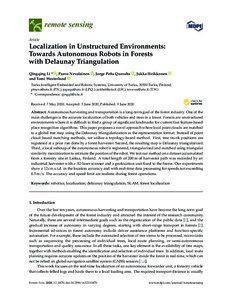Localization in Unstructured Environments: Towards Autonomous Robots in Forests with Delaunay Triangulation
Jorge Peña Queralta; Jukka Heikkonen; Paavo Nevalainen; QingQing Li; Tomi Westerlund
https://urn.fi/URN:NBN:fi-fe2021042827200
Tiivistelmä
Autonomous harvesting and transportation is a long-term goal of the forest industry. One of the main challenges is the accurate localization of both vehicles and trees in a forest. Forests are unstructured environments where it is difficult to find a group of significant landmarks for current fast feature-based place recognition algorithms. This paper proposes a novel approach where local point clouds are matched to a global tree map using the Delaunay triangularization as the representation format. Instead of point cloud based matching methods, we utilize a topology-based method. First, tree trunk positions are registered at a prior run done by a forest harvester. Second, the resulting map is Delaunay triangularized. Third, a local submap of the autonomous robot is registered, triangularized and matched using triangular similarity maximization to estimate the position of the robot. We test our method on a dataset accumulated from a forestry site at Lieksa, Finland. A total length of 200 m of harvester path was recorded by an industrial harvester with a 3D laser scanner and a geolocation unit fixed to the frame. Our experiments show a 12 cm s.t.d. in the location accuracy and with real-time data processing for speeds not exceeding 0.5 m/s. The accuracy and speed limit are realistic during forest operations.
Kokoelmat
- Rinnakkaistallenteet [19207]
